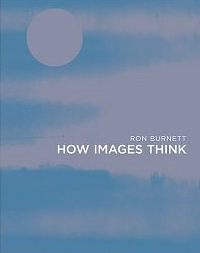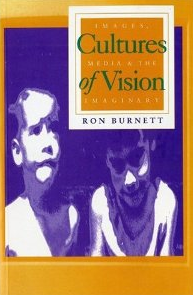Books by Ron Burnett
I have written two books and edited another. They are, How Images Think which was published by MIT Press in 2005, Cultures of Vision: Images, Media and the Imaginary published by Indiana University Press in 1995 and Explorations in Film Theory published in 1991 which is a selection of articles from a Journal I published and edited from 1976-1983 named Ciné-Tracts.

[Amazon]
James Elkins has written an excellent review of How Images Think. Elkins.pdf
Professor Pramod Nayar of the Department of English, University of Hyderabad comments on “How Images Think.” This is a small selection of a longer review that appeared in the Journal of the American Society for Information Science and Technology.
“How Images Think is an exercise both in philosophical meditation and critical theorizing about media, images, affects, and cognition. Burnett combines the insights of neuroscience with theories of cognition and the computer sciences. He argues that contemporary metaphors - biological or mechanical - about either cognition, images, or computer intelligence severely limit our understanding of the image. He suggests in his introduction that image refers to the complex set of interactions that constitute everyday life in image-worlds (p. xviii). For Burnett the fact that increasing amounts of intelligence are being programmed into technologies and devices that use images as their main form of interaction and communication - computers, for instance - suggests that images are interfaces, structuring interaction, people, and the environment they share.
New technologies are not simply extensions of human abilities and needs - they literally enlarge cultural and social preconceptions of the relationship between body and mind.
The flow of information today is part of a continuum, with exceptional events standing as punctuation marks. This flow connects a variety of sources, some of which are continuous - available 24 hours - or live and radically alters issues of memory and history. Television and the Internet, notes Burnett, are not simply a simulated world - they are the world, and the distinctions between natural and non-natural have disappeared. Increasingly, we immerse ourselves in the image, as if we are there. We rarely become conscious of the fact that we are watching images of events - for all perceptive, cognitive, and interpretive purposes, the image is the event for us.”
Hart Cohen has written an excellent review of Cultures of Vision:
"This book on visualization, media, and culture though published in 1995 maintains a strong presence in a field where obsolescence of content and methodology is swift and brutal. Professor Ron Burnett was formerly Director of the Graduate Program in Communications, McGill University, and is now President of Vancouver’s Emily Carr Institute of Art and Design. Though attention is given in this book to Canadian individuals like Michael Snow and institutions such as the NFBC, the Canadian dimensions to this text are located much more in the perspectives offered to the problems under examination than in the media practices themselves. In the Canadian context, an organic link exists between communications and media studies and Canadian intellectual traditions. From Innis and McLuhan to Dallas Smythe and a host of contemporary writers and thinkers, Canadians have been prominent in the relatively recent dialogues formative of the debates in this field.
Burnett’s book, in this regard, is a substantive and critical intervention. It builds an argument on the strength of a rigourous treatment of visualization, a manner of questioning the boundaries between seeing and imaging, between those practices which place the eye at the center of a mass-mediated social subject. Burnett’s argument is woven like a tapestry rather than built Kuleshovian style “brick by brick.” “Clint Eastwood’s Magnum” and “The Death of Kurt Cobain” are offered as slivers of reflections which parallel and cross other threads of analytical work including commentary on a number of films from Fassbinder to Woody Allen.
This is not a critical media text in which the reader can retreat into comfortable binarisms of theory and practice or subject and object. Media practices are placed in the context of specific arguments (e.g., the political effectivity of video activism or the communalizing efforts of visual media) and here, in the cross-fertilization of unlikely bedfellows, insights are formulated in the most original of meetings: art video and political video; Sadie Benning and Jean Baudrillard; Aboriginal media and Seinfeld.
Without a doubt this book is playing the role of a transition text in the field of media and cultural studies—occupying the dimensions of the spectrum which span mass media and new media. Finding new media aesthetics in the post-mass media of the 1990s, Burnett is keen to push the limits of media and cultural theory to permit the full range of media its varied and contradictory impacts. Further analysis of a simultaneous yet highly contradictory set of “other” media—media of the Other and by the Other—finds the postmodern and the postcolonial as fading yet grasping intellectual turns unable to reconcile the traditional and spiritual elements of modernity with the pressures they exert on community and social life. Rather than map this contradiction, Burnett has traversed its territory finding the extraterritoriality of the media in the evacuated space of national and cultural formations. In stressing the reading, seeing, and making of media, Burnett is really setting up a series of conversations about media as a form of thought in which the dialectic of seeing and thinking becomes the language through which media speaks its subjects … and through which its subjects reflect on the practices which extend their influence socially and politically."
Cultures of Vision: Images, Media and the Imaginary



